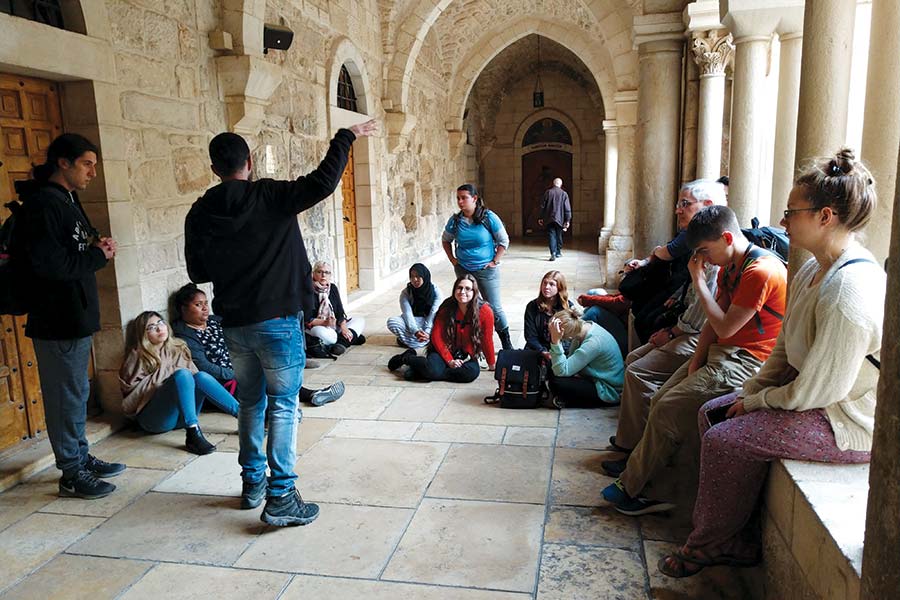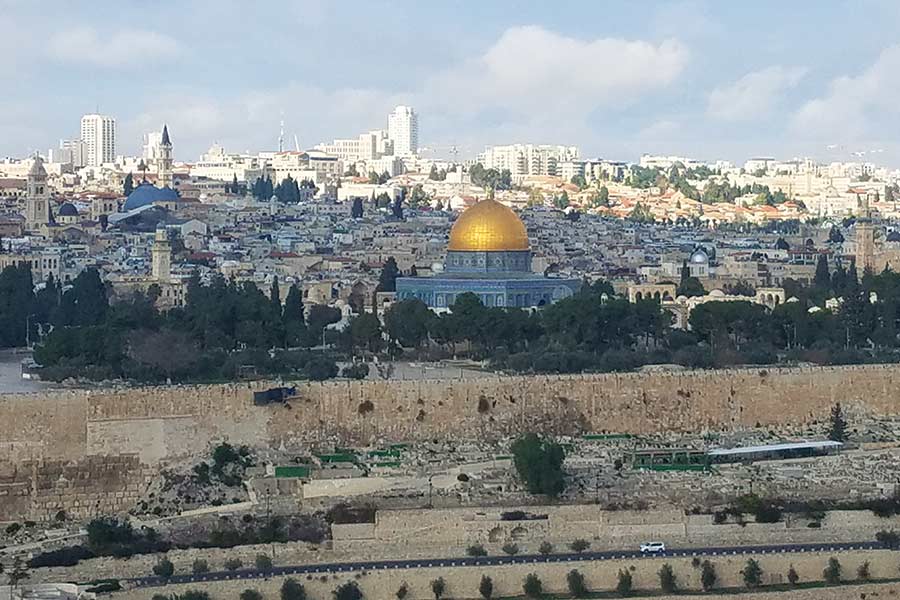Students explore one of the many freshwater cisterns inside the ancient fortress of Masada, which overlooks the Dead Sea. From left to right: Iesha Said, Danica Dosmann, Irein Thomas, Anna Rhodes, Judith Espinoza, Alex Fluegel, and Acacia Berg. Photo by Submitted
First, some recent history: Before Israel declared its independence in 1948 and claimed West Jerusalem as part of its territory, the United Nations intended Jerusalem to become an international city.
By the conclusion of the Arab-Israeli War in 1949, however, West Jerusalem had come fully under Israeli control, and East Jerusalem—which includes the Old City and religious sites of importance to Muslims, Jews, and Christians—was under the control of Jordan. This arrangement lasted until the Six-Day War of 1967, when Israel took possession of East Jerusalem and parts of the West Bank. Since then, the status of Jerusalem has been a major sticking point in Israeli-Palestinian peace negotiations, with both sides claiming Jerusalem as their rightful capital.
Today, about 20 percent of Israel’s 9 million residents are Arabs, the Palestinian Authority oversees the occupied territories of the Gaza Strip and the West Bank (where Israeli Jews also live, through a deliberate and questionably legal effort to establish Jewish settlements there), and, despite years of negotiations, a solution seems as distant as it ever has.
It was this conflict that the 15 students in HIST/RELS 271G: Jerusalem set out to explore during fall term 2018. An outgrowth of Assistant Professor of History Danielle Steen Fatkin’s course on the history of the Israel-Palestine Conflict—which examined the ancient history and archaeology of Jerusalem and its relationship to the modern conflict between Israel and Palestine— “Jerusalem” aimed to help students understand both the history and the current reality of the residents of the city—Jewish, Christian, and Muslim; Israeli and Palestinian. At winter break, students then traveled around Israel, the West Bank, and Jerusalem for two weeks, meeting people from every side of the conflict and visiting the sites that have made Jerusalem so important to so many different people—the Al Aqsa Mosque, the Dome of the Rock, the Western Wall, and the Church of the Holy Sepulchre, among others.
When they returned, the class held a research forum to share some of their experiences traveling in Israel and Palestine and the questions their travels raised.
WHAT’S IN A NAME?
Riley Grossman ’19 noted a strong preference among her classmates for referring to the West Bank and Gaza not as Israel or Palestine but as “the Occupied Territories.” She said, “A lot of Israelis don’t call it that. You know— religious Jews, or people who are very into the Zionist movement, call it ‘Judea’ and ‘Samaria,’ which were the Biblical names for those areas. You can tell actually a lot of someone’s political standing and what they think about this conflict by how they name it.”
HOW DO YOU MAKE GOOD CHOICES IF YOU DON’T HAVE ANY?
Senior Judith Espinoza decided to focus on Hamas (the Islamic Resistance Movement, based in Gaza) for her class research project. Though governments in the West regard Hamas as an Islamic fundamentalist terrorist organization, inside Gaza, it is not only the controlling political authority but one of the few sources of social welfare programs for Palestinians. “Hamas exists because of the conditions in Gaza,” she said, “which many consider to be the world’s largest open-air prison. People are not allowed to leave Gaza. It has no international recognition. Because of the population density, when there are attacks on the West Bank, it’s almost guaranteed that a lot of people will die and lose their homes.”
Residents told her there’s a lack of food, water, and electricity. “We heard reports that there will be maybe two hours of electricity a day for a normal family in Gaza. There are a lot of restrictions on what kind of supplies can come into the area. There are curfews. And there is also the issue of Israeli settlers. When settlers decide to take a space in the West Bank, it means there’s going to be an even greater demand on scarce resources.”
Hamas provides healthcare, education, and job training for its supporters. It also offers compensation for the families of the “martyrs” who volunteer as suicide bombers. “Because there’s very limited opportunity for Palestinians living in the area, if you’re living in poverty, in terrible conditions, then it’s not illogical to think, well, if I commit an act of terror, at least my family’s going to have enough to get by. It’s very, very dark to think this way, but poverty and inequality don’t really promote ethical and rational thinking.”

“
They kept asking me, ‘Are you here because of your heritage?’ And I kept trying to explain that I was traveling as part of a class.”
Iesha Said, Knox College junior
HOW DOES IT FEEL TO BE A NON-JEW IN A JEWISH STATE?
In the United States, junior Iesha Said—whose Muslim parents emigrated to the United States from Ethiopia before she was born—identifies as African American. As soon as she landed in Israel, however, she was assigned a new all-encompassing identity: Muslim. At the airport in Tel Aviv, she was the first to immigration and passport control, anticipating that it might take her a little longer to get through. She was right—officials pulled her aside and questioned her for approximately 90 minutes before she was granted entry. “They kept asking me, ‘Are you here because of your heritage?’ And I kept trying to explain that I was traveling as part of a class.”
It was her first taste of what it’s like to be a Muslim in a nation where Muslims, especially Arab Muslims, are sometimes objects of hatred and fear. To Israelis seeing her hijab and dark complexion, she looked Palestinian. “In Orthodox [Jewish] areas, I felt invisible. In Muslim areas, people just seemed confused—why is that Muslim girl hanging out with those tourists?”
The constant scrutiny and misunderstanding led to a profound realization for her. “Religious identity in Israel is like race in America,” she says. “You can’t escape it.”
CAN ANYTHING BE DONE?
While there have been moments in the last 30 years where it seemed there might be a solution to the Israel-Palestine conflict, the peace process has been at a virtual standstill since 2014, when Israel suspended talks after the newly formed Palestinian government included representatives from Hamas. (This summer, the Trump Administration announced a new peace plan for the region, but the Palestinian Authority says it was not consulted and therefore will not participate in discussions.) “I would say changing the hearts and minds of young people is one important part,” said Irein Thomas ’19. “They’re the future lawmakers.”

WHAT IF YOU’RE LEFT WITH MORE QUESTIONS THAN ANSWERS?
Fatkin’s specialty is ancient history and archaeology, but she noted that while the group spent a great deal of time visiting Masada, the Dead Sea, and the Old City of Jerusalem, what they wanted to write and talk about when they got home wasn’t archaeology. And that’s fine with her—the goal was to introduce students to a part of the world “that is so often talked about and so poorly understood by so many people.”
Their trip went off without a hitch, and Fatkin hopes to offer the course again in two years—but planning ahead can be particularly challenging. “We were so lucky. We were there from November 27 until December 9. And on December 13, just four days after we had been in Ramallah, Israel closed Ramallah and sent in the police to conduct a massive manhunt because a settler had been shot outside of Bethlehem.
“What we walked away with is the sense of how difficult life can be day to day for so many people living in Israel and Palestine."
This immersive experience for Knox students was made possible in part by funding from the Knight Endowed Fund for the Study of Religion and Culture and the Glossberg Jewish Studies Fund, which support classroom education and faculty enrichment and help students seek wisdom and guidance as they work their way through important issues at Knox and in the world that awaits them.